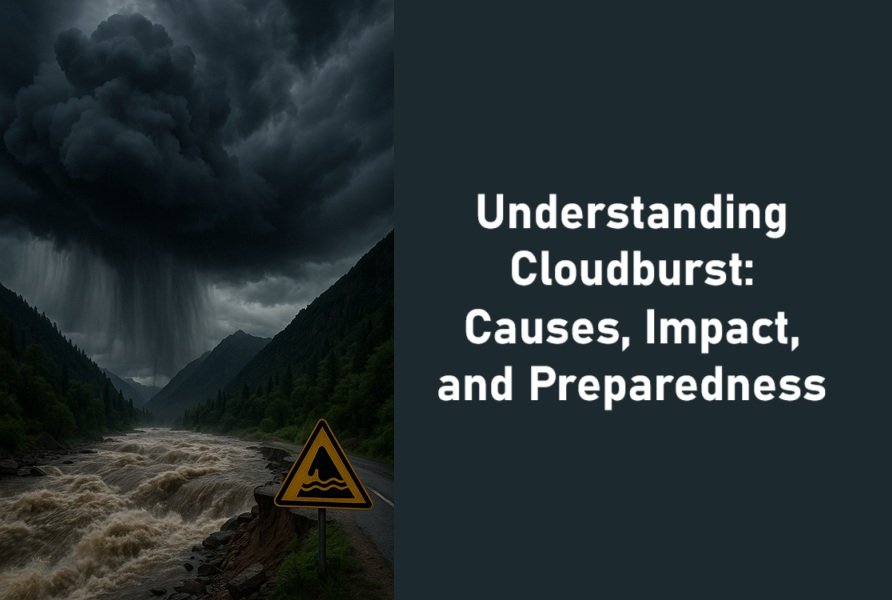
Introduction: What is a Cloudburst?
A cloudburst is an extreme and sudden downpour of rain, often accompanied by thunder and lightning, that results in flash floods and severe damage to life and property. Typically localized to a small area (often less than 20 to 25 square kilometers), a cloudburst can cause rainfall exceeding 100 mm (4 inches) per hour. It is an extremely dangerous weather event, especially in hilly or mountainous regions.
The term “cloudburst” gives the impression of clouds suddenly bursting open, though technically it’s a misnomer. The phenomenon does not involve clouds physically bursting but rather intense rainfall due to atmospheric conditions.
Causes of Cloudbursts
Cloudbursts result from specific meteorological conditions, including:
1. Orographic Lifting
In mountainous regions like the Himalayas, moist air masses are forced to rise due to the terrain. As the air ascends, it cools and condenses, forming rain clouds. If this process continues rapidly and moisture keeps accumulating, it can lead to a cloudburst.
2. Presence of Humid Air
When high amounts of moisture-laden air from oceans or monsoons converge over a region, it creates unstable atmospheric conditions. If these clouds remain stationary over an area for too long, rainfall can reach catastrophic levels.
3. Temperature Inversions
In temperature inversion, a warm layer of air traps cooler air below, which can cause massive buildup of moisture, leading to heavy precipitation in a short span.
4. Atmospheric Instability
Intense solar heating of the earth’s surface can create convective currents that lift moist air rapidly. If conditions are right, cumulonimbus clouds form and burst into a torrential downpour.
Why Do Cloudbursts Occur in Hilly Regions?
Mountainous regions like Jammu & Kashmir, Himachal Pradesh, Uttarakhand, and the North Eastern States of India are prone to cloudbursts due to:
- Steep gradients that cause orographic lifting.
- Rapid changes in temperature and pressure.
- Convergence of monsoon winds with Western Disturbances.
The Himalayan terrain amplifies the effects of rainfall because the water has no way to seep into the ground quickly—it flows down steep slopes, turning into deadly flash floods within minutes.
Cloudburst vs. Heavy Rainfall: Key Differences
| Parameter | Cloudburst | Heavy Rainfall |
|---|---|---|
| Rainfall Intensity | >100 mm/hour | 64.5 mm to 115.5 mm/hour |
| Duration | Short (minutes to a few hours) | Can last for hours or days |
| Area Affected | Highly localized (less than 25 sq km) | Larger region |
| Associated Risks | Flash floods, landslides | Waterlogging, river flooding |
Impacts of Cloudbursts
1. Flash Floods
Sudden runoff causes rivers and streams to overflow, damaging infrastructure and endangering lives.
2. Landslides
Saturated soil in hilly areas becomes unstable, causing landslides that destroy roads, buildings, and villages.
3. Destruction of Property
The water carries boulders, mud, and debris that can flatten homes, wash away vehicles, and destroy farmland.
4. Loss of Life
Many cloudbursts occur during the night, catching people off-guard. The loss of human life can be devastating.
5. Infrastructure Damage
Bridges, highways, and electricity lines are severely affected, isolating communities and delaying rescue operations.
Notable Cloudburst Incidents in India
1. Leh, Ladakh (August 2010)
- Over 200 mm of rain fell in less than 30 minutes.
- Over 200 people killed, hundreds injured.
- Mudslides and floods damaged hospitals, army bases, and the airport.
2. Kedarnath, Uttarakhand (June 2013)
Though not purely a cloudburst, the event involved unprecedented rainfall and glacial lake outburst.
- 5,000+ lives lost.
- Kedarnath town submerged and cut off.
- Worst natural disaster in the Himalayas since 2004 tsunami.
3. Amarnath Yatra Area (July 2022)
- Cloudburst near the cave shrine of Amarnath.
- At least 15 pilgrims lost their lives.
- Rescue efforts severely hampered due to terrain and weather.
4. Himachal Pradesh and Uttarakhand (2023–2025)
- Increasing frequency of cloudbursts noted due to climate change.
- Roads, bridges, and villages were washed away multiple times over monsoon seasons.
Role of Climate Change in Increasing Cloudbursts
Global warming is intensifying the Indian monsoon system, making rainfall more erratic and intense. The warmer atmosphere can hold more moisture, which is released as extreme precipitation during storms. Cloudburst events are now:
- More frequent
- More intense
- Occurring in new regions (e.g., Maharashtra, Rajasthan)
Cloudburst Early Warning and Monitoring
1. IMD (India Meteorological Department)
- Uses Doppler weather radars, satellite imagery, and surface stations.
- Issues nowcasts (short-term weather forecasts) for cloudburst-prone areas.
2. ISRO Satellites
- Monitor cloud cover and precipitation in real time.
- Help local authorities plan evacuation and alert systems.
3. Local Administration
- Alert villagers and tourists.
- Temporarily halt yatras or trekking routes.
- Coordinate with NDMA and NDRF for disaster response.
What to Do Before, During, and After a Cloudburst
Before a Cloudburst:
- Check weather updates regularly if in a hilly area.
- Avoid camping near riverbanks or mountain slopes during the monsoon.
- Have an evacuation plan if you live in or visit prone areas.
During a Cloudburst:
- Seek higher ground immediately.
- Stay away from rivers, bridges, and landslide zones.
- Don’t try to drive or walk through rushing water.
After a Cloudburst:
- Wait for official all-clear signals.
- Be cautious of loose electrical wires, open manholes, and unstable ground.
- Help others and contact disaster relief services if needed.
Technological Solutions and Future Preparedness
- Smart Weather Stations in remote villages.
- Integration of AI in real-time data analysis.
- Drones and satellite mapping for damage assessment.
- Awareness programs for tourists, trekkers, and pilgrims.
Read This: Summer Solstice 2025: Embracing the Longest Day of the Year
Conclusion
Cloudbursts are natural yet terrifying phenomena that reflect the power and unpredictability of nature. While we cannot completely prevent them, scientific forecasting, community awareness, and rapid disaster response can help save lives and reduce the damage. With changing climate patterns, the need for robust infrastructure and policy-level planning has never been more urgent.
Understanding cloudbursts is not just about weather—it’s about saving communities, preserving biodiversity, and learning to respect the natural balance of our environment.






